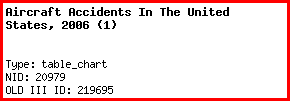MEMBERSHIP
AMPLIFY
EN ESPAÑOL
Connect With Us
- Popular search terms
- Automobile
- Home + Renters
- Claims
- Fraud
- Hurricane
- Popular Topics
- Automobile
- Home + Renters
- The Basics
- Disaster + Preparation
- Life Insurance
An Airbus 340 Air France Jet (part of the Air France-KLM Group) carrying 309 people skidded off a runway and burst into flames Tuesday afternoon, August 2, 2005, while landing in Toronto during a dangerous thunderstorm.
No deaths were reported in this disaster, however the European insurance industry could potentially see claims of up to $100 million on the aircraft's "hull" coverage. Additional liability claims for the medical expenses of those injured in the accident may also be filed. However, because there were no deaths and relatively few injuries, the cost of such claims should be limited. Individual companies’ liabilities could be limited by a pooled risk system.
Had the crash resulted in a worst-case scenario involving large-scale loss of life, insurance costs would have been much higher. Among airlines based in modern economies (e.g, North America, Western Europe and Japan, for example) compensation payments to the families of airline crash victims can run from $2.4 million to $4.1 million per passenger, which suggests the total cost to insurers could have been between $700 million to nearly $1.3 billion.
The largest single settlement in the history of aviation in the U.S. was to the estate of Marshall Berkman, who was CEO of Ampco Pittsburgh Corp. Settlements are usually based on the potential salary of the individual over the span of his or her lifetime.
The Air France Concorde plane, which crashed on July 25, 2000 was insured for $30 million. A total of 113 people were killed when the charter flight went down in the first-ever crash of a Concorde.
A Swissair jetliner, bound from New York to Geneva, Switzerland, crashed off the coast of Nova Scotia on September 2, 1998 killing 229 people after its pilot reported smoke in the cockpit and attempted an emergency landing at Halifax International Airport.
Here are the latest worldwide and U.S. aviation accident statistics.
WORLDWIDE SCHEDULED AIR SERVICE FATAL ACCIDENTS, 1998-2007
|
Source: International Civil Aviation Organization.
In the U.S. there were 1,715 civil aviation accidents in 2004, down from 1,864 in 2003. Total fatalities also fell, from 695 to 635. Accident rates per 100,000 flight hours fell in 2004 for all categories.
There were 13 fatalities on large scheduled commercial airlines in 2004, compared with 22 in 2003. There were 531 in 2001, the worst year for fatalities since 1977. Half of 2001’s fatalities resulted from the September 11 hijackings.
Large nonscheduled airlines (charter airlines) had seven accidents, one fatal, in 2004, compared with two nonfatal accidents in 2003. Small scheduled airlines had five accidents in 2004, compared with two in 2003. Small nonscheduled airlines (air taxis), had 68 accidents in 2004, down from 77 in 2003. Sixty-five people died in air taxi accidents in 2004, compared with 45 in 2003.
There were 1,614 general aviation accidents in 2004, resulting in 556 deaths, compared with 1,732 accidents resulting in 626 deaths in 2003.
